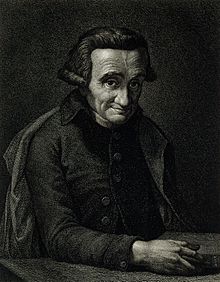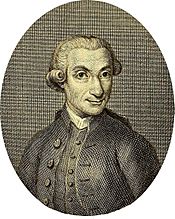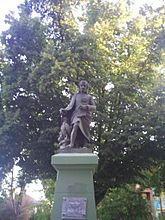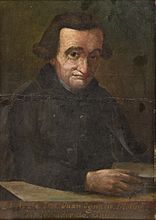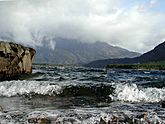Juan Ignacio Molina facts for kids
Quick facts for kids
Juan Ignacio Molina
|
|
|---|---|
| Born | June 24, 1740 Guaraculén, Captaincy General of Chile (now Chile)
|
| Died | September 12, 1829 (aged 89) |
| Resting place | Villa Alegre |
| Nationality | Chilean |
| Other names | "Abate Molina” |
| Occupation | priest, naturalist, historian, translator, geographer, botanist, ornithologist, scientific, linguist. |
| Employer | University of Bologna |
| Board member of | Academy of Sciences of the Institute of Bologna |
Juan Ignacio Molina (June 24, 1740 – September 12, 1829) was a Chilean Jesuit priest. He was a very smart person who studied many things. He was a naturalist, meaning he studied nature. He was also a historian, a geographer, a botanist (someone who studies plants), and an ornithologist (someone who studies birds). People often called him Abate Molina.
Molina was one of the first people to suggest that living things slowly change over time. This idea is called gradual evolution. He wrote about this 44 years before Charles Darwin did. Darwin even mentioned Molina in his famous book, "The Origin of Species."
Contents
Biography of Juan Ignacio Molina
Early Life and Education
Juan Ignacio Molina was born on June 24, 1740, in Guaraculén, a large farm in Chile. He lived there until he was five years old. His parents were Agustín Molina and Francisca González Bruna.
From a young age, Juan Ignacio loved observing nature. He enjoyed watching animals and plants on his family's farm. He wrote about this interest, saying he loved to "observe nature and particularly animals."
When he was five, his family moved to Talca. There, he started school with the Jesuits, a group of Catholic priests known for their excellent teaching. Molina was a very bright student. He learned quickly and had a great memory. He even started teaching younger students when he was still young himself.
At age fifteen, he joined the Jesuits because he was so good at his studies, especially in Latin. He continued his studies in different places like Talca, Concepción, and Santiago. He spent time at a place called Bucalemu, where he studied classic books and natural sciences. By the time he was 20, he knew Latin, Greek, French, and Italian very well. This skill helped him become a librarian for the Jesuits in Santiago in 1760.
Life in Exile
In 1768, Molina had to leave Chile. This happened because the Society of Jesus was forced to leave many countries. He moved to Italy and settled in the city of Bologna.
Because he was so good with languages, he became a professor of Greek at the University of Bologna. He soon became known as a great historian and geographer. He wrote important books like "Saggio sulla Storia Naturale del Chili" (1778) and another book in 1787. Later, in 1803, he became a professor of Natural Sciences.
In 1782, he published "Saggio sulla Storia Naturale del Cile." This book was the first to describe the natural history of Chile. It introduced many Chilean plants and animals to the scientific world. His works were translated into German, Spanish, French, and English, making him famous. Even the famous explorer Alexander von Humboldt wanted to meet him.
Important Works and Ideas
Molina wrote in a clear and elegant style. He was very careful and hardworking in his research. He spent a lot of time in libraries, taking notes on everything he found interesting. He was also kind and loved by his students. He taught them Latin, history, and geography.
One of his most interesting works was "Less Observed Analogies of the Three Kingdoms of Nature" (1815). In this book, he suggested a theory of gradual evolution, 44 years before Charles Darwin. Molina believed that nature was a continuous chain. He thought that minerals, plants, and animals were connected and gradually changed from one form to another. For example, he said that simple plants came after crystalline minerals, and complex animals came after complex plants.
In another work, "On the Propagation of Mankind in the Various Parts of the Earth" (1818), Molina suggested that the physical differences among people are due to climate and geography.
His ideas caused some debate. A former student accused him of heresy, which means going against religious beliefs. The Bishop of Bologna asked a group of religious scholars to review his work. They found nothing wrong with his writings, but the delay meant his book "Analogías" was not published widely for a long time. This might have prevented him from being recognized as a pioneer of evolution theory.
Later Years and Legacy
Molina stayed in touch with his family in Chile until 1795. He learned about the deaths of his mother, brother, and nephew. When his nephew Agustín died in 1815, Molina became the sole heir to his family's property in Chile.
His other nephew, Ignacio Opazo Castro, helped manage the family's assets. Molina hoped to use some of his inheritance to return to Chile. He was 75 years old and longed to see his homeland again. He even planned a trip in 1816. However, his nephew Ignacio died, and the money could not be sent to him in time.
After his last relative died, Molina's inheritance was managed by different people. Eventually, the new Republic of Chile mistakenly used some of his money to build the First Chilean Navy Squadron. However, the money was returned to him in 1820.
Molina continued to live in Bologna. He was loved by those around him. In 1823, he received a visit from José Ignacio Cienfuegos, which gave him hope. Cienfuegos told him about what was happening in Chile. Molina, despite his age, still wanted to go back. He wanted to "see his beloved land" and "give hugs to his compatriots."
During their conversation, Molina expressed his wish to use his money to build a school in Talca. Cienfuegos helped make this happen. A Literary Institute was created in Talca, where students could learn Spanish, Latin, Philosophy, and Theology. Molina was happy to see his dream of helping education come true.
His health slowly declined after 1814. He could still read and teach children for free until 1825. In his last days, he suffered from old age and a constant thirst. He would ask for "Fresh water from the Cordillera!" remembering the pure water from the Andes Mountains in Chile. Juan Ignacio Molina died on September 12, 1829, at the age of 89.
Scientific Contributions
As a scientist from the Americas, Molina often disagreed with European experts who wrote about his continent. He criticized Cornelius de Pauw, who he felt tried to "degrade and discredit the Americas." Molina argued against De Pauw's claims about the Americas having poor minerals or people living shorter lives.
Molina also had ideas about how rocks formed. In his book "Ensayo sobre la historia natural de Chile," he suggested that basalt rock came from sediments, not volcanoes. He noticed basalt in places like the Andes and the coast of Chiloé where there were no signs of eruptions. He thought basalt was a type of compacted slate.
As early as 1787, Molina thought that South America might have been settled by people coming from south Asia. He imagined they traveled through the "infinite island chains" of the Pacific Ocean. He also thought North America could have been settled by people from Siberia.
Plant Classification (Botanical Taxonomy)
Other scientists honored Juan Ignacio Molina by naming plants after him.
- The plant genus Molina was named after him by Hipólito Ruiz López and José Antonio Pavón Jiménez. This genus is now considered a subgenus of Baccharis.
- Another genus of grasses, Moliniopsis, was also named in his honor.
- Molina is also connected to the naming of the plant genus Maytenus.
Animal Classification (Zoological Taxonomy)
A species of Chilean lizard, Liolaemus molinai, is named after him to honor his work in zoology.
Images for kids
See also
 In Spanish: Juan Ignacio Molina para niños
In Spanish: Juan Ignacio Molina para niños
- Miguel de Olivares
- Alonso de Ovalle
- Juan de la Cruz y Bernardotte
- List of Jesuit scientists
- List of Roman Catholic scientist-clerics
- Founding of Talca
- Pedro Nolasco Vergara Albano
- Juan Albano Pereira Márquez


